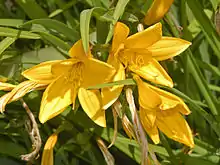| Hemerocallis citrina | |
|---|---|
 | |
| At the Jardin des Plantes, Paris | |
| Scientific classification | |
| Kingdom: | Plantae |
| Clade: | Tracheophytes |
| Clade: | Angiosperms |
| Clade: | Monocots |
| Order: | Asparagales |
| Family: | Asphodelaceae |
| Subfamily: | Hemerocallidoideae |
| Genus: | Hemerocallis |
| Species: | H. citrina |
| Binomial name | |
| Hemerocallis citrina Baroni[1] | |
Hemerocallis citrina, common names citron daylily[2] and long yellow daylily, is a species of herbaceous perennial plant in the family Asphodelaceae.
Description
Hemerocallis citrina can reach a height of 90–120 centimetres (35–47 in). It has bright green, linear arching leaves about 40 cm long. Flowers are lemon yellow, trumpet-shaped, showy and very fragrant, about 15 centimetres (5.9 in) in diameter. They bloom from June to July.
Long yellow day lily is cultivated in Asia for its edible flowers.
Distribution and habitat
This species is native to East Asia and China. It grows in forest margins, grassy fields and slopes, at an elevation of 0–2,000 metres (0–6,562 ft) above sea level.
Constituents
There is a belief that this plant contains colchicine. However, this plant doesn't have colchicine.[3]
Culinary uses
The tubers, inflorescences, buds and flowers can all be cooked and eaten.
Dried or fresh flowers, sometimes called "gum jum" or "golden needles" (Chinese: 金針; pinyin: jīnzhēn) or as huánghuācài (黃花菜, lit. 'yellow flower vegetable') are used in Chinese cuisine for dishes including hot and sour soup, daylily soup (金針花湯), Buddha's delight, and moo shu pork.[4]
In Burmese, dried daylily flowers are called pangyauk (ပန်းခြောက်; lit. 'dried flower'), and feature in several soups and Burmese salads, including kya zan hinga.
Toxicity
Consuming its raw or undercooked non-dried flowers may cause unwellness.[5] Symptoms include vomiting, abdominal pain and diarrhea.[6]
References
- ↑ "Hemerocallis citrina Baroni". Plants of the World Online. Royal Botanic Gardens, Kew. Retrieved 16 January 2020.
- ↑ USDA, NRCS (n.d.). "Hemerocallis citrina". The PLANTS Database (plants.usda.gov). Greensboro, North Carolina: National Plant Data Team. Retrieved 19 January 2016.
- ↑ Qing ZX, Liu JH, Yi XX, Liu XB, Hu GA, Lao J, He W, Yang ZH, Zou XY, Sun MS, Huang P, Zeng JG (2021). "The chromosome-level Hemerocallis citrina Borani genome provides new insights into the rutin biosynthesis and the lack of colchicine". Horticulture Research. Nature Portfolio. 8 (1): 89. doi:10.1038/s41438-021-00539-6. PMC 8027641. PMID 33828071.
- ↑ "Hemerocallis citrina". Archived from the original on 2015-07-11. Retrieved 2016-02-01.
- ↑ 何航敏 (1978). "食用新鲜黄花菜引起食物中毒42例调查". 铁道医学 (2): 92.
- ↑ 刘国舜 (1989). "鲜黄花菜致食物中毒27例报告". 学校卫生. 10 (2): 53.
External links
- Missouri Botanical Garden
- Tropicos
- The Plant List
- "Hemerocallis citrina". Plants for a Future.
- Flora of China Editorial Committee. 2000. Flora of China (Flagellariaceae through Marantaceae). 24: 1–431. In C. Y. Wu, P. H. Raven & D. Y. Hong Fl. China. Science Press & Missouri Botanical Garden Press, Beijing & St. Louis.